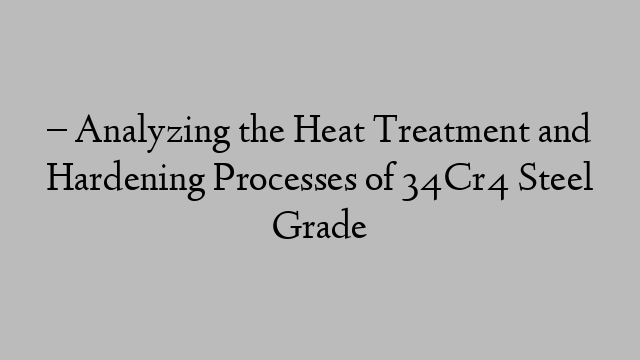Address
304 North Cardinal St.
Dorchester Center, MA 02124
Work Hours
Monday to Friday: 7AM - 7PM
Weekend: 10AM - 5PM
Address
304 North Cardinal St.
Dorchester Center, MA 02124
Work Hours
Monday to Friday: 7AM - 7PM
Weekend: 10AM - 5PM

The 34Cr4 steel grade is a low-alloy steel commonly used for applications requiring high strength, such as in automotive components and industrial machinery. Analyzing the heat treatment and hardening processes of this steel grade involves examining its mechanical properties, chemical composition, and the specific heat treatment steps.
Chemical Composition:
The 34Cr4 steel grade belongs to the group of quenched and tempered steels, with a defined chemical composition. The primary elements and their approximate weight percentages are as follows:
– Carbon (C): 0.30-0.37%
– Silicon (Si): 0.40% max
– Manganese (Mn): 0.50-0.80%
– Phosphorus (P): 0.035% max
– Sulfur (S): 0.020% max
– Chromium (Cr): 0.80-1.10%
Mechanical Properties:
The mechanical properties of the 34Cr4 steel grade are crucial for analyzing its heat treatment and hardening processes. These properties typically include:
– Tensile strength: The maximum amount of tensile stress a material can withstand before breaking.
– Yield strength: The stress at which the material begins to deform plastically and lose its elasticity.
– Elongation: The percentage increase in length the material can withstand before fracture.
– Hardness: The resistance of the material to indentation or scratching.
Heat Treatment:
Heat treatment is an essential process to enhance the mechanical properties of 34Cr4 steel grade. The typical heat treatment steps for this steel grade include:
1. Annealing: The material is heated to a temperature of around 750-850°C for a specific time to relieve internal stresses and improve machinability.
2. Quenching: The material is rapidly cooled from a high temperature to room temperature or below, typically in oil or water. This process increases hardness and helps to achieve the desired microstructure.
3. Tempering: The quenched material is reheated to a specific temperature (around 150-300°C) and held there for a specified time to reduce brittleness and increase toughness.
Hardening:
The hardening process is usually combined with the heat treatment process to achieve maximum strength and hardness in the 34Cr4 steel grade. This involves heating the material to a temperature around 860-890°C and then quenching it in oil or water. The result is an increased hardness that meets the desired mechanical properties.
By analyzing the heat treatment and hardening processes of the 34Cr4 steel grade, manufacturers and engineers can ensure that the material has the necessary mechanical properties and is suitable for its intended application.
34Cr4 Steel grade
1698372505